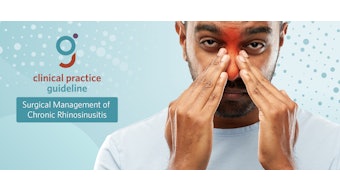Voice Disorders in Older Adults Require a Proactive Approach
As the aging population grows rapidly, otolaryngologists must proactively address age-related vocal fold atrophy through evidence-based interventions.
Adam R. Szymanowski, MD

As the United States experiences unprecedented growth of its older population, clinicians will encounter more patients with age-related vocal fold atrophy (ARVA). Between 1920 and 2020, the number of Americans ages 65 and older increased nearly five times faster than the general population. Currently, adults over 65 comprise approximately 17% of the U.S. population, a figure anticipated to exceed 22% by 2040. Within this population, an estimated 30% of individuals suffer from ARVA, or presbyphonia.1,2 This demographic shift and the prevalence of voice disorders in older patients underscores the importance of understanding and addressing vocal health in this population.3
Pathophysiology of Age-Related Vocal Fold Atrophy (ARVA)
ARVA arises because of distinct histopathological changes that occur naturally within aging vocal folds. As we age, the volume of superficial lamina propria decreases, elastin content diminishes, and collagen becomes denser and less organized. These changes alter the biomechanical properties of the vocal folds, leading to vocal fold bowing and glottic insufficiency. This manifests clinically as hoarseness, decreased vocal projection, vocal fatigue, and effortful phonation.4
Psychosocial Impacts of Presbyphonia
Voice changes associated with presbyphonia significantly affect older adults' quality of life and contribute to diminished social interaction and emotional health. Older patients frequently express distress, frustration, embarrassment, and reduced self-esteem owing to declining vocal function. This often leads them to withdraw from social and community activities, increasing their risk for adverse physical and mental health outcomes.5
Unfortunately, many individuals mistakenly attribute their worsening voice to normal aging and often resign themselves to declining vocal function, unaware that therapeutic options exist that may improve their voice quality and quality of life. This misconception underscores the need for improved patient education and clinician advocacy to facilitate timely interventions that can mitigate the adverse psychosocial effects of ARVA.2,5
Current Treatment Approaches and Challenges
Despite the availability of several effective therapeutic approaches, uncertainty remains regarding the optimal management strategy for presbyphonia. Currently, otolaryngologists commonly employ voice therapy or surgical augmentation of the vocal folds such as injection laryngoplasty, medialization thyroplasty, or a combination of both. Voice therapy, which frequently involves vocal function exercises and resonant voice techniques, serves as an essential nonsurgical first-line treatment, though patient compliance can be challenging. Completion rates for voice therapy in older patients may be as low as 30%, limiting overall treatment effectiveness. 6
The Underutilized Role of Injection Augmentation
Injection augmentation procedures, both temporary and permanent, have emerged as important interventions to improve glottic competence and reduce vocal fold bowing. However, despite promising outcomes, vocal fold injections remain underutilized in clinical practice.7 Vocal fold injections can be used not only as a primary treatment but also as a valuable diagnostic tool to identify which patients may benefit most from permanent surgical medialization procedures. Given the current absence of clear guidelines, clinicians can consider employing trial vocal fold injections to predict which patients will experience long-term benefits from permanent augmentation techniques, bridging the gap in clinical decision-making until definitive treatment algorithms are established.7
Evidence-Based Findings and Future Directions
A recent systematic review by Bhatt et al. (2023) evaluated treatments for ARVA, comparing the effectiveness of surgery (injection laryngoplasty, bilateral thyroplasty) and voice therapy to control groups.8 The review demonstrated that both surgical and behavioral treatments were superior to control groups across outcome measures, including endoscopic, acoustic, auditory-perceptual, and patient-reported assessments.
However, no single treatment consistently demonstrated clear superiority across all outcome domains. Notably, surgical interventions were associated with a low incidence of adverse events, highlighting the safety and potential benefits of surgical management strategies.8 These findings suggest that broader application of trial injections in managing ARVA could lead to better patient selection for definitive surgical treatments.
Toward Better ARVA Management Guidelines
The ongoing demographic shift in the U.S. and other countries toward an older population necessitates robust clinical research to establish evidence-based guidelines for presbyphonia management. Current research is limited by heterogeneity in outcome measures and variability in study design. Future studies should adopt standardized voice outcome measures, incorporate patient-reported quality-of-life indices, and systematically evaluate the role of frailty and extra-laryngeal factors in treatment response.
Although clear guidelines remain elusive, current evidence supports voice therapy and surgical augmentation as safe, effective treatments. Vocal fold injection trials, currently underused, provide an essential bridge toward evidence-based care, helping clinicians identify patients who would most benefit from definitive surgical intervention until clearer clinical algorithms become available.7,8
References
- Golub JS, et al. Prevalence of perceived dysphonia in a geriatric population. J Am Geriatr Soc. 2006;54:1736–1739.
- Davids T, et al. Current dysphonia trends in patients over the age of 65: Is vocal atrophy becoming more prevalent? Laryngoscope. 2012;122(2):332–335.
- Caplan Z, Rabe M. The Older Population: 2020. U.S. Census Bureau; 2023.
- Madruga de Melo EC, et al. Distribution of collagen in the lamina propria of the human vocal fold. Laryngoscope. 2003;113(12):2187-2191.
- Etter NM, et al. Defining the lived experience of older adults with voice disorders. J Voice. 2013;27(1):61-67.
- Ebersole B, et al. Role of occupational voice demand and patient-rated impairment in voice therapy adherence. J Voice. 2018;32(3):325-331.
- Miaskiewicz B, et al. Injection laryngoplasty as an effective treatment method for glottal insufficiency in aged patients. Am J Otolaryngol. 2021;42(6):103353.
- Bhatt NK, et al. Treatments for age‐related vocal atrophy: A systematic review. Laryngoscope. 2023;133(11):2846-2855.


















